|
Monarchs-And-Milkweed.com Frequently Asked Questions |
![]()
![]()
![]()
Why
Can't
You Ship Butterflies, Eggs,
Caterpillars, and Chrysalises to
My State?
If you wish to
raise and/or release butterflies, you have two options for obtaining them. The
first option is to capture butterflies that naturally reside within the borders
of the state you live in. With few exceptions it is completely legal to do this.
The second option for obtaining butterflies is to purchase them from a
professional butterfly farmer, a person who grows and sells butterflies for
profit.
The United States
Dept. of Agriculture (USDA) determines which butterflies can be released in what
state and also regulates the interstate movement of butterflies. The USDA makes
its decisions based on a number of things. First, and most important, the
butterfly must naturally reside in the state where it is being shipped to. If
there are subspecies of a butterfly, the USDA attempts to keep those subspecies
geographically separated from each other.
As previously
mentioned, it is legal to catch, raise, and/or release any butterfly that you
find within the borders of the state you reside in, so long as that particular
butterfly isnít restricted from being captured in the wild. Butterflies on the
threatened or endangered species list are not allowed to be taken from their
natural environment. While there are limited exceptions to this rule, it is
generally illegal to remove an endangered butterfly (in any life stage) from its
location in the wild.
There are four
butterfly species which are allowed to be released in any U.S. state and may
legally be shipped to and from any of the 48 contiguous U.S. states. These are
the Painted Lady, the American Lady, the Red Admiral, and the Cabbage White.
Five other
butterfly species (Monarch, Black Swallowtail, Giant Swallowtail, Mourning
Cloak, and Gulf Fritillary) are allowed to be shipped from one contiguous U.S.
state to another so long as the USDA allows that particular butterfly to be
shipped into that particular state, and then if, and only if, the shipper has a
permit from the USDA to ship it.
Aside from the
five butterflies listed above (Monarch, Black Swallowtail, Giant Swallowtail,
Mourning Cloak, and Gulf Fritillary), it is illegal to ship, or in any other way
transport, butterflies from one state to another without a permit. This being
said, there are exceptions to this rule also. Butterfly exhibits, educational
institutions, and such are sometimes able to obtain specialized permits from the
USDA to receive butterflies that are not among the five butterflies listed
above.
The Monarch
butterfly is not permitted to be shipped across the Continental Divide, not in
either direction. Monarchs also cannot be shipped to Arizona, Montana, or
Nevada.
To make matters
even more complicated, some states prohibit even particular naturally occurring
butterflies from being shipped into them. Black Swallowtails naturally occur in
Maryland, but Maryland does not permit this butterfly species to be shipped into
it from other states. Monarchs, Black Swallowtails, and Mourning Cloaks may be
shipped into Connecticut but no butterfly species is permitted to be released
into the wild in that state.
As you can see,
itís a rather difficult job keeping track of which butterfly can be released
in which state and also determining which butterfly can be shipped where. And to
make it even more difficult, the rules often change every couple of years.
![]()
Sorry, we do not publish a catalog.
Some of our milkweed plants sell out earlier than we hoped during the growing season
(May thru October). The plant species we offer in May might differ from what we
offer in July, and what we offer in July could be different from what we offer in
October. Because our inventory changes from month to month, a printed catalog just
would not work for our business.
We generally don't start shipping Monarch eggs, caterpillars, or
pupae until mid to late June. Between then and late September (when we stopping
shipping for the season), we sometimes sell out of eggs, caterpillars, and/or
pupae and must temporarily remove the shopping cart buttons from the web site.
We update our web pages on a regular basis during our growing
season so that it accurately reflects what we have available for
shipping. We remove shopping cart buttons when plants or Monarchs sell out, even
when it's only temporarily---then add the buttons as soon as we have more stock
to ship.
Our web site functions as our catalog. If you like our web site and
might like to place an order sometime (or just revisit for any reason),
please bookmark it.
![]()
We suggest cutting butterfly bushes back to about 4 feet high
for the winter (so that heavy winter snow won't crush the bush to the ground).
And don't cut the butterfly bushes back too early; November is our
recommendation.
Depending upon the severity of winter, your butterfly bush may
appear dead in spring. Don't despair. Even when a butterfly bush doesn't develop
leaf buds on the previous year's branches, it will usually sprout new growth
from the root system. Be patient though. It might be late May before your butterfly
bush shows signs of new growth.
In early June, cut off any branches which died over the winter.
This is also a good time to trim the butterfly bush to the shape you'd like it
to be.
During its blooming period, usually mid July through September, you
might deadhead (remove spend flowers) every two weeks or so. This assures that
the bush will put its energy into producing more flowers rather than seed.
![]()
To determine the zone you live in, you must look at a USDA Plant Hardiness Zone Map. Often you will find these maps in seed, bulb, and perennial plant catalogs. We have included a plant hardiness zone map on our web site too. You can view it by clicking here on USDA Plant Hardiness Zone Map. Please be patient while the picture downloads.
![]()
The U.S. Department of Agriculture-Animal & Plant Health
Inspection Service (APHIS), and the plant health agencies in each of the 50
states, regulate the interstate shipment of nursery and greenhouse stock. The
regulations exist to minimize the spread of harmful insects, diseases, and other
pests from one state to another.
By shipping plants bare root, a grower is permitted to ship to many
more states than a grower who ships plants in soil. This is because soil can
harbor numerous insects and diseases which do not occur above the soil line.
Shipping plants in soil, as we do, dramatically decreases the number of states
to which we can ship.
While we regret that we cannot ship to most states in the USA, we
feel confident that what we do ship will arrive at its destination in good
condition because it is shipped in soil, the same soil the plants have been
growing in for months.
We would like to expand the territory to which we can ship plants
but we can't. The U.S. Department of Agriculture and the plant health agencies
in each state, for good reason, forbids that.
We are able to ship plants to these states: Alabama, Arkansas, Connecticut, Delaware,
Georgia, Illinois, Indiana, Kentucky, Massachusetts, Maryland, Maine, Michigan,
Minnesota, Missouri, North
Carolina, New Hampshire, New Jersey, New York, Ohio, Pennsylvania, Rhode Island,
South Carolina, Tennessee, Virginia, Vermont, West Virginia, and Wisconsin.
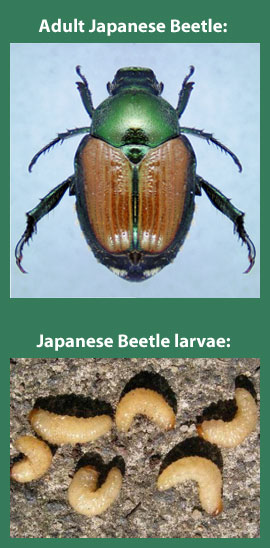 |
The
USDA Japanese Beetle Quarantine:
Japanese Beetles are highly destructive insects. They feed on the foliage, flowers, and fruit of over 300 plant species. They can completely defoliate a plant when they attack in large numbers. Japanese Beetles are
native to Japanese Beetles lay their eggs in soil. The eggs hatch in eight to fourteen days. The larvae, which are grubs, feed mostly on grass roots and can severely damage lawns, golf courses, and pasture fields. In October, the grubs dig deeper into the soil to over-winter. Around mid April they come out of hibernation, begin to feed again, grow to a mature size of about 1Ē long, and then pupate. In June adult beetles begin to emerge from the pupae and rampantly feed on foliage, flowers, and fruit. Because they are so destructive, the USDA imposed the Japanese Beetle Quarantine. The quarantine restricts the movement of soil that could potentially be infected with Japanese Beetle eggs and/or larvae into areas not yet heavily infected with this insect. Since most of my plants are grown outdoors in pots, Japanese Beetles eggs and/or larvae could be in the soil. Hence, my plants cannot be shipped to those states which are not yet heavily infected with Japanese Beetles. |
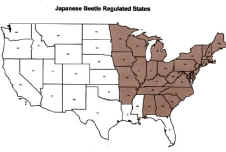 |
|
Restrictions are imposed on the movement of soil that
could potentially be infected with Japanese Beetle larvae from the
quarantined (shaded) areas into or through the unshaded areas (the
area not yet heavily infected with Japanese Beetles). We are located
in Pennsylvania and are thus, are only permitted to ship our potted
perennials to the states that are in the quarantined (shaded) area.
|
![]()
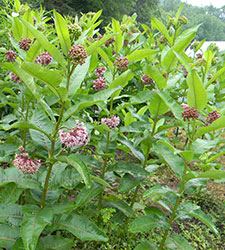 |
How is milkweed essential for the existance of the monarch butterfly?
Adult monarchs (and many other butterfly species) love
nectar-rich milkweed as a food source, but there is a more important reason for
the monarch's close attachment to milkweed. Milkweed is the only plant material
that monarch caterpillars can eat. Remove monarch caterpillars from milkweed and
they will starve; or they will eat other plant material, sicken, and then die. The scientific name for milkweed is Asclepias (pronounced as-KLEE-pea-us).
Asclepias syriaca (common milkweed, pictured here), is well known to most
northeasterners.
It
grows along roadsides, in fields, and in open meadows. Producing
sweet smelling mauve-pink flowers late June through July, common milkweed
usually matures at about 48" high. Some people assume common milkweed to be
the only milkweed species which exists. Actually, over 100 species of
Asclepias grow in the USA, with over 200 different species growing worldwide.
|
![]()
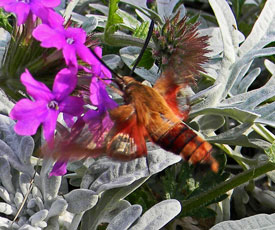 |
What's this critter that looks somewhat like a hummingbird but isn't a hummingbird ?This is a Hummingbird Clearwing Moth. It belongs to the family of sphinx moths, which are daylight fliers. Like most moths and butterflies, the hummingbird clearwing moth sips nectar through a coiled tube (proboscis) which extends from its mouth. This moth has a wingspan of 1-1/2" to 2-1/2" and feeds in mid-air while beating its wings at a rapid rate (just like a hummingbird). A regular visitor to butterfly bushes, hummingbird clearwing moths also like the nectar of beebalm, phlox, lilac, thistle, and more.
|
![]()
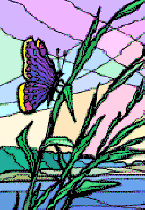
|
Rose Franklin's
Perennials (814)
422-8968
Email: MilkweedLady@aol.com |
|
|
Copyright © 2002-2018. [Rose Franklin's Perennials]. All rights reserved.
Revised: February 25, 2021